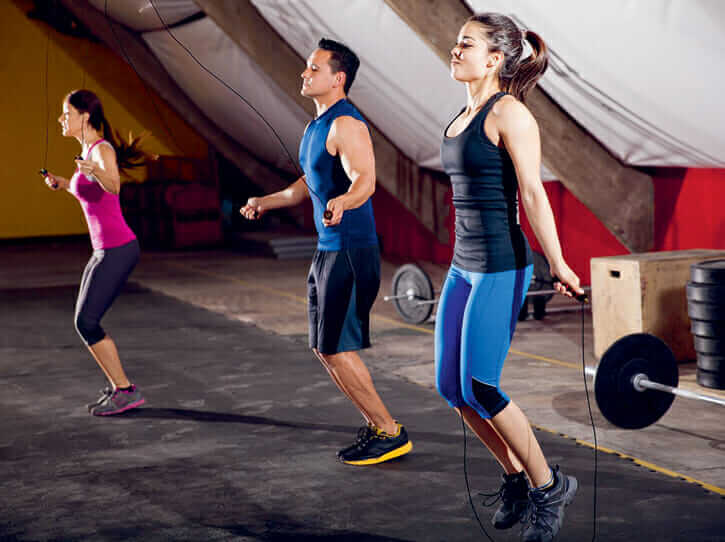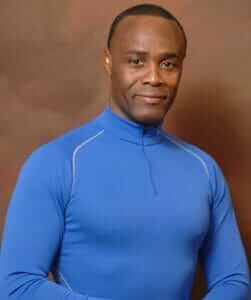2019 promises to be the year of the jump rope and we’ve got the world’s leading jump rope expert Buddy Lee with a brand new book 101 Best Jump Rope Workouts.
Jump rope is ranked as one of the most efficient exercises for improving cardiovascular health. Variations in jump speed, jumping patterns, jump techniques and jump progressions all lead to making jump rope one of the most effective and versatile exercises on the planet.
10 minutes of jump rope can provide the same cardiovascular benefits as…
- 2 sets of tennis
- Swimming 720 yards in 12 minutes
- 22.5 minutes of golf
- 14.5 minutes of skating
- Running a mile in 12 minutes
- Biking 2 miles in 6 minutes
Choosing the Right Equipment
Different rope materials provide different training effects. A beaded rope is well balanced, easy to control and is great for learning the basics. A Speed Rope is lightweight and designed to generate speeds up to 5 rotations per second (RPS) for faster reflexes and reaction times. This transfers over to increased speed, quickness and agility. A Super Speed Rope provides the same benefits and more, being capable of 6or more RPS. A Heavy Rope has weights (either in the handles or distributed throughout the cord or cable) which creates a greater centrifugal pull, improves gripping strength and challenges the forearms and shoulders to increase upper body strength.
Measuring Rope for Your Height
To properly measure your jump rope to match your height:
1. Stand on the center of rope with one foot.
2. Extend the tip of the handles to reach from the ground to your:
a. shoulder (beginner)
b. under arm (intermediate)
c. lower chest (advanced)
d. lower ribcage (competitive jumper)
The shoulder measurement is a guideline and should provide sufficient clearance for starting out in your jump rope program. Once you become more proficient at jumping, adjust your rope to a desired shorter length (b through d) for maximum benefits. (For more information, see Buddy Lee’s videos and book at learnhowtojump.com).
The Right Footwear
Wear training shoes that fit the shape of your feet and provide adequate support, especially under the balls of your feet, since jumping activity requires bounding on the balls of your feet. You can choose whichever brand best suits you.
The Best Surface
You can jump almost anywhere. Be sure to choose a surface that provides sufficient “give,” especially during the takeoff phase. You’ll also want the necessary support during the landing phase of each jump. Wooden and rubberized surfaces are overall the best choices, as they consistently provide equal give and rebound. The surfaces listed below absorb and spread impact over a longer time and distance, providing for minimum impact and reduced risk of injury.
Biomechanics of Jumping Rope
Jump rope is a continuous and repetitive cyclic motion that requires control during the load, flight and landing phase—all while balancing one’s body weight evenly on the balls of your feet. Jump rope is a learned skill and requires total body movement and major muscle recruitment. When you jump rope, many muscle groups of the upper and lower body are called into action. During the load, propulsion, airborne and landing phase of the jump, different muscle groups come into action to complete the skill successfully.
As such, jumping involves synchronization and coordination of both circular and linear movement. The greatest benefits are derived from the integration of upper and lower body movements in synchronization with the turning of the rope, while moving in all planes at various intensities.
For each successful jump, you are required to master proper timing and coordination of the rope swing, while at the same time gripping the handles to harness the power from the centrifugal tendencies of the rope. These complex actions develop great kinesthetic awareness and fine tune motor-skills. It is in this process of performing high intensity, continuous non-stop jumping in different planes, where the multi-benefits of jump rope are achieved.
What is Shadow Jumping?
Shadow jumping is a simulation of jumping rope—without the rope. It will help prepare you for actual rope jumping, while executing different hand and foot patterns. In addition to the Basic Bounce, you can apply steps 1 and 2 of this tool to all the other jump rope techniques in this book.
Here are the three steps to Shadow Jumping:
1. Practice the takeoff and landing of the Basic Bounce without the rope, jumping 0.5 to 1 inch off the ground.
2. Practice the Basic Bounce, while swinging the rope to the side of your body. This will develop the necessary timing for coordinating the rope swing with each jump.
3. From a starting position, rest the rope behind slightly bent knees. Keep your elbows at a 90-degree angle with your arms held close to your sides. With a small circular wrist movement, practice swinging the rope over your head in a nice even arc. The loop should be wide enough for you to easily jump through. Your hands should stay in the same position throughout the movement.
Take Safety Precautions
While jump rope is intended to be a low-impact exercise, it can be high-impact when performed incorrectly! Please consult with your primary care physician before starting the jump rope workouts in this book, especially if you are suffering from any kind of health issue or bodily injury which may prevent you from participating in exercise.
For more jump rope workouts and guidance, visit Buddy Lee at buddyleejumpropes.com and check out his new book 101 Best Jump Rope Workouts.
Buddy Lee is known as one of the world’s top experts in jump rope conditioning. He has earned a worldwide reputation with his incredible jump rope skills, putting on 6,000 shows in 50 countries and appearing in TV commercials and talk shows. A retired U.S. Marine and U.S. Olympian in wrestling, Buddy now consults with strength and conditioning coaches worldwide as well as elite athletes from various disciplines. Many sports and fitness organizations, such as CrossFit, TRX, 9Round Fitness, US Olympic Teams, UFC Gyms and the US Government, have integrated Buddy Lee’s program into their systems. He currently lives in the Washington D.C. area.







